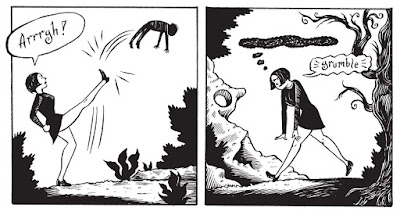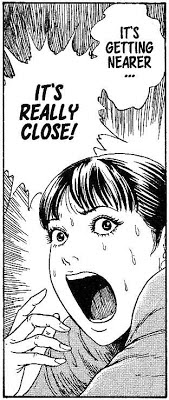Frankenstein (2018, Viz Media)
Story and Art: Junji Ito
Rating: Eight of Ten Stars
Junji Ito is an undisputed master of horror comics. He is one of the few creators who can make comics as unsettling as a good piece of horror fiction, or a well-made horror movie. He's been writing and drawing horror tales since 1987, and he's only been getting better as the years have passed; almost every artist reaches a peak and then starts to decline... Ito, thankfully, hasn't gotten to that point yet.
One of the most recent collections of his work to be printed in English is "Frankenstein." The book draws its title from a rare long-form effort, an adaptation of Mary Shelley's novel that takes up roughly have the pages, with eight shot horror tales, and two cute little pet stories, filling the rest of book.
Ito's "Frankenstein" is a little over 180 pages in length, and it is one of the best comics adaptations of Shelly's novel that I've read; it's almost as good as
the one by Mike Friedrich and Mike Ploog published by Marvel Comics in the early 1970s, which remains my favorite. Where the Marvel adaptation took its visual inspiration from Universal Pictures movies released during the late 1930s and early 1940s, Ito's visualization of Victor Frankenstein and his creation seemed more inspired by
the movies from the 1950s and 1960s released by Hammer Films; there is more than one panel where Frankenstein has an uncanny resemblance to Peter Cushing. The monster also bears a passing similarity to the make-up job on Christopher Lee in 1957's "The Curse of Frankenstein"... but it's a very slight one.
Lovers of Ito's typical style may find his "Frankenstein" adaptation a little long-winded, because it contains none of the Lovecraftian horror they are used to. Further, unlike his other adaptation of a classic--his take on "Snow White and the Seven Dwarves", which can be summarized as "
Tomie Meets Fantasy"--Ito doesn't stray far from his source. Some events from the novel are condensed or glossed over, but it's far more faithful an adaptation than most, and thus it's something that may be appreciated more by general horror fans, or fans of gothic horror, than Ito's dedicated followers.
In fact, the only thing about Ito's "Frankenstein" adaptation that I'd peg as Signature Ito is the appearance of the monster. Everything else about the story seems more restrained and in keeping with the tone and style of the source novel than his usual output. This makes the grotesque nature of Frankenstein's monstrous creation such a striking element that the reader easily shares in the horror felt by the characters in the story. On the reverse side, Ito's characterization of the monster is such that the reader initially feels great sympathy for it, because all it wants is safety and acceptance and love. Once the creature realizes it will never have those things, and embarks on its quest for revenge against Frankenstein, the reader loses that sympathy, although retains a full understanding of why the monster behaves as it does, even if Frankenstein may not. At the end of the adaptation, however, readers will once again feel sympathy for the monster, because, like an abused child or animal, all the violence and acts of evil it committed were a cray for its creator's acceptance, attention, and even the love it so desperately wanted.
Also included in this collection are all the tales focusing on a teenaged boy named Oshikiri. The first couple of tales seem like they are completely unrelated except for the fact that they, strangely, feature the same main character. There appears to be no continuity between them since in the first story he is a psychopathic killer and in the second story he's a lonely boy who becomes attracted to a similarly lonely girl... who turns out to be unhinged. The strange twist ending of the second story, however, sets the stage for the revelation in stories that follow that Oshikiri's house is riddled with portals to other realities, and that people are passing back and forth between them, sometimes at will, sometimes by accident. The last tales in the Oshikiri Cycle (to give the group of stories a name) are a two-part tour-de-forces that include everything regular readers associate with Junji Ito's work--unexplained supernatural horrors, strange bodily transformations, and creeping insanity--and ends with a very creepy final image that implies the multi-universal horror continues on.

Rounding out the book are two stand-alone horror stories and two brief tales about Non-Non, Ito's mother's dog. The pet stories have a charming, rather than chilling, vibe to them, just like the cat stories in
Yon & Mu. The two horror stories are some of the weaker efforts I've seen from Ito, with mercifully brief "The Hell of the Doll Funeral" being among his worst (treading similar ground to that he covered so much better in "Dying Young" from the
Flesh-Colored Horror anthology), and "Face Firmly in Place", a tale that must have been inspired by Ito's days working in the dentistry field, but which, while a solid excursion into terror, is undermined by an unrealistic situation--unless clinics and hospitals in Japan are run in a completely incompetent fashion.
Despite the inclusion of two weak short stories, this book is a great read that I recommend highly. Once again, I feel that Ito's work will appeal to horror fans who even like to say they don't like "manga". In fact, those two weak stories barely impacted my rating at all... I'm giving the book Eight Stars because I will forever knock a Full Star off any book that features the sort of sloppy translations that have become the accepted standard in the marketplace where the book reads from what is normally the back and to the front and from right-to-left, because that is how it reads in the original Japanese. Most readers don't mind, so it's just my personal issue. .





 "Gyo" was originally published in serialized form in the Japanese anthology title "Big Comics Spirit" during 2001 and 2002. It was Ito's final excursion into horror before taking a decade-long break from the genre (returning to horror by writing and directing a film adaptation of his most famous series, "Tomie" in 2011, and afterwards to comics). The art is as solid as in any of Ito's prior work--with some scenes being every bit as nightmarishly disturbing as the best found in his "Flesh-Colored Horror" anthology. Unfortunately, that's as far as it goes.
"Gyo" was originally published in serialized form in the Japanese anthology title "Big Comics Spirit" during 2001 and 2002. It was Ito's final excursion into horror before taking a decade-long break from the genre (returning to horror by writing and directing a film adaptation of his most famous series, "Tomie" in 2011, and afterwards to comics). The art is as solid as in any of Ito's prior work--with some scenes being every bit as nightmarishly disturbing as the best found in his "Flesh-Colored Horror" anthology. Unfortunately, that's as far as it goes.










